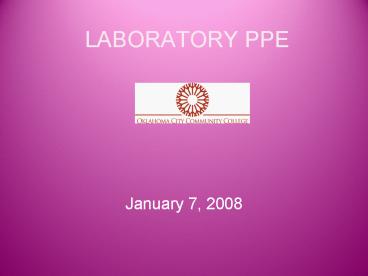LABORATORY PPE - PowerPoint PPT Presentation
1 / 15
Title:
LABORATORY PPE
Description:
If infectious materials are present, snapped lab coats and gloves are essential; ... Before removal rinse gloves thoroughly; Remove gloves before leaving the ... – PowerPoint PPT presentation
Number of Views:690
Avg rating:3.0/5.0
Title: LABORATORY PPE
1
LABORATORY PPE
- January 7, 2008
2
IntroductionWhat is PPE?
- Personal protective equipment (PPE) includes all
types of equipment used to increase individual
safety while performing potentially hazardous
tasks. This may include safety glasses, hard
hats, gloves, lab coats, respirators, or any
equipment used to protect against injury or
illness.
3
OSHA Regulations Require
- Employers conduct hazard assessments to determine
use of PPE - Employers certify in writing hazard assessments
conducted - PPE selected on basis of hazard assessments and
workers properly trained
4
OSHA Regulations Require
- Defective PPE must not be used
- Employers provide PPE training to employees
- Employers certify in writing PPE training
provided and understood by employees.
5
PPE Training Requirements(29 CFR 1910.132(f)
- When PPE is necessary
- What PPE is necessary
- How to properly don, doff, adjust and wear PPE
- The limitations of the PPE and
- Proper care, maintenance, useful life and
disposal of PPE.
6
Eye Protection
- Eye protection is mandatory in all areas where
there is a potential for injury. - The type of eye protection required depends on
the hazard. For most situations safety glasses
with side shields are adequate. - Goggles or face shields are required in specific
operations where there is danger from splashes of
corrosive liquids or flying particles.
7
Eye Protection
- If a splash occurs proceed to nearest eyewash
fountain and flush eyes with water from the eye
outward for at least 15-30 minutes. A co-worker
should notify the proper authorities. - Recommended that contact lenses not be worn in
laboratory. - Visitors shall follow the same eye protection
policy as employees.
8
Clothing
- Lab coats should be worn at all times in the lab
areas - If infectious materials are present, snapped lab
coats and gloves are essential - Shoes must be worn at all times. No sandals or
open-toed shoes allowed - Consult MSDS for recommended clothing or PPE for
particular chemicals.
9
Following guidelines offered from a safety
standpoint
- Torn clothing should be avoided unless wearing a
lab coat - Dangling jewelry and excessively long hair pose
safety hazards (ignition, absorption and
entanglement) - Rings or other jewelry not easily removed should
be avoided - Lab coats should not be worn outside the lab.
10
ApronsRubber or Plastic?
- Plastic or rubber aprons may be supplied for
handling large quantities of corrosive liquids in
open containers - Rubberized laboratory apron or chemical- and
fire-resistant laboratory coat should be worn
when conducting experiments - Always wear long-sleeved and long-legged clothing.
11
Gloves
- Gloves protect workers from accidental spills or
contamination - Contaminated gloves should be removed and
disposed of properly - No glove exist that protects workers against all
chemicals - Proper glove selection is essential.
12
Glove Selection
- Use rubber or neoprene gloves for concentrated
acids, alkalis, organic solvents - Use heat-resistant gloves for handling hot
objects - Special insulated gloves should be worn when
handling very cold objects.
13
Glove Inspection
- Before using inspect for discoloration,
punctures, and tears - Always rinse with a compatible solvent prior to
handling wash bottles or other laboratory
fixtures - Before removal rinse gloves thoroughly
- Remove gloves before leaving the immediate work
site to prevent contamination - Always remove by pulling the cuff over the hand.
14
Respirators
- Respirator use should be avoided if possible
- Not required if proper engineering controls are
being practiced (fume hoods, etc.) - If respirators are warranted, a respirator
program must be established in accordance with 29
CFR 1910.134.
15
Questions
- Talk with your immediate supervisor regarding
questions on any material in this presentation
or - Contact the Office of Risk Management
Environmental Health Safety at 405-682-1611,
ext. 7148 or email lvaughan_at_occc.edu.

